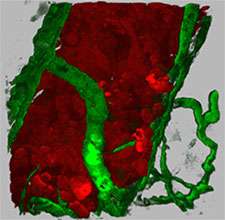Transparent Zebrafish Help Researchers Track Breast Cancer

What if doctors could peer through a patient’s skin and see a cancer tumor growing? They’d be able to study how tumor cells migrate: how they look, how they interact with the blood system to find nourishment to grow and spread through the body.
Scientists at the University of California, San Diego (UCSD) School of Medicine can’t look through human skin. But a small, tropical minnow fish common to aquariums has given UCSD researchers a window for viewing live, human cancer cells in action. Working with transparent zebrafish to study one of the most aggressive forms of cancer, inflammatory breast cancer, has led to their discovery of how two proteins interact in the metastasis of breast cancer.
The study led by Richard Klemke, Ph.D., professor of pathology at UCSD School of Medicine and the UCSD Moores Cancer Center, will be published in the Proceedings of the National Academy of Sciences online edition the week of October 22-26.
“By watching human breast cancer cells in real time in the live transgenic zebrafish, we were able to determine that two proteins are required in order for breast tumor cells to complete the most critical step of metastasis – entering the blood vessels,” said Konstantin Stoletov, Ph.D., of the department of pathology at the UC-San Diego School of Medicine, first author of the paper.
The scientists discovered that two proteins work together to allow cancerous breast tumors to enter the blood vessels, thus promoting metastasis. The first is vascular endothelial growth factor (VEGF), a protein made by cancerous cells that stimulates new blood vessel formation, or angiogenesis. The second is a small protein called RhoC that is involved in cell movement or migration, and is overexpressed in highly metastatic forms of breast cancer.
The researchers found that neither VEGF nor RhoC alone interact with blood vessels to allow the cancerous tumor to enter the blood vessels, or intravasate. “But together, they promote rapid intravasation,” said Stoletov.
Inflammatory breast cancer (IBC) is the deadliest form of human breast cancer, with fewer than half of those diagnosed today expected to live five years. The UCSD team developed an immuno-suppressed zebrafish that expresses green fluorescent protein (commonly known as GFP) only in its blood vessels, allowing scientists to view the tumor-induced blood vessel formation, or angiogenesis. They injected the fish with IBC cells that were tagged in different colors, in order to study the very rapid tumor progression.
The parental cancer cells were tagged in blue, and the migrating cells that overexpressed RhoC in red. Over several weeks, the researchers were able to watch the cancer’s progression using high-resolution, multi-color confocal microscopy.
The scientists discovered that RhoC induces an amoeboid-like mode of invasion, in which the cancerous cells move by means of temporary projections or ‘false feet.’ They also found that secretion of VEGF was required in order for the cancer cells to penetrate and enter the blood vessel.
“In later stages of the cancerous tumor, the VEGF induces rapid formation of irregular, leaky blood vessels,” said Stoletov. “We discovered that intravasation requires the secretion of VEGF, which disrupts the blood vessel wall, creating small openings that allow the tumor cells to penetrate and enter.”
Finding a way to suppress VEGF, thus inhibiting the growth of “leaky” blood vessels, could stop the movement of cancer cells into the blood vessels and the tumor’s subsequent metastasis, according to Klemke.
The results provide novel insight into mechanisms of cancer-cell invasion and intravasation, showing how RhoC and VEGF cooperate to facilitate cell metastasis in living tissues. The transparency of the fish also allowed the researchers to image and analyze, in three dimensions, images of a potential anti-cancer compound that inhibits the VEGF receptor. They found that this inhibitor prevents formation of the vascular openings, thus inhibiting intravasation.
Source: University of California, San Diego



















